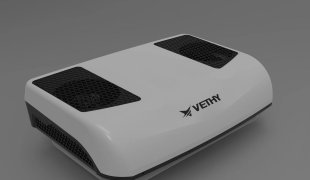Why 12V Aluminum Tube Parking AC Systems Are Obsolete: A User-Centric Revolution
April 20, 2025
Introduction
As the demand for reliable, energy-efficient climate control in recreational vehicles (RVs) and commercial trucks surges, outdated technologies like 12V aluminum tube parking air conditioners are rapidly disappearing. While these systems once dominated the market, their decline is no accident. Driven by material flaws, inefficient performance, and a seismic shift toward user-centric design, of aluminum-based 12V AC units reflects a broader industry transformation. This article explores the technical, regulatory, and experiential factors behind this shift, emphasizing why product experience now dictates market survival.
Part 1: The Technical Pitfalls of 12V Aluminum Tube Systems
1.1 Material Weaknesses: Corrosion and Fragility
Aluminum, once praised for its lightweight properties, is inherently prone to oxidation and pitting corrosion. In humid or salty environments—common in coastal RV trips or long-haul trucking routes—aluminum tubes develop micro-leaks, reducing refrigerant efficiency and requiring frequent repairs. A 2024 study by the HVAC Innovation Institute found that aluminum-based AC systems in RVs fail 42% faster than copper alternatives under similar conditions.
For example, users in Florida’s tropical climate reported replacing aluminum coils every 18–24 months, compared to copper systems lasting 5+ years. This not only increases costs but disrupts travel plans—a critical pain point for adventurers (see our guide to RV maintenance on vethy.com).
1.2 Thermal Inefficiency and Power Limitations
Aluminum’s thermal conductivity (237 W/m·K) lags behind copper (401 W/m·K), forcing 12V systems to work harder to achieve cooling. Combined with voltage constraints, this results in sluggish performance. Tests by Cooling Tech Magazine showed that a 12V aluminum AC unit takes 25% longer to cool a standard RV cabin than a 24V copper system.
Moreover, 12V systems drain vehicle batteries rapidly. Truck drivers often face dead batteries after overnight use, risking delivery delays. As energy expert Dr. Lena Müller states, “12V is fundamentally mismatched with modern cooling demands—it’s like using a horse cart on a freeway.”
Part 2: The Rise of Advanced Alternatives
2.1 Material Innovations: Copper and Hybrid Polymers
Copper’s corrosion resistance and superior heat exchange have made it the gold standard. Brands like Dometic and Tecma now use copper tubes with polymer coatings to further enhance durability. For instance, Dometic’s latest RV AC line boasts a 10-year warranty, a feat unthinkable for aluminum systems.
Hybrid materials are also gaining traction. Nordic Van Solutions employs graphene-infused tubes, which improve conductivity by 15% while reducing weight. Learn more about next-gen HVAC materials.
2.2 High-Voltage Systems: 24V and 48V Architectures
Transitioning to 24V/48V systems resolves power bottlenecks. These setups reduce current flow, minimizing energy loss and heat generation. A 2023 report by Frost & Sullivan revealed that 24V RV AC units consume 30% less battery than 12V models, extending off-grid usability.
Companies like Victron Energy now offer 48V lithium-ion batteries paired with smart inverters, enabling seamless integration with high-efficiency AC systems. Explore 48V battery solutions.
2.3 Smart Technology and IoT Integration
Modern systems prioritize user convenience. Webasto’s CoolTop RT7, for example, connects to smartphones for remote temperature control and energy monitoring. Such features align with RV owners’ demand for “set-and-forget” reliability—a stark contrast to manual, maintenance-heavy aluminum units.
Part 3: Regulatory and Environmental Pressures
3.1 Stricter Energy Efficiency Standards
Global regulations now penalize inefficient cooling systems. The EU’s Eco-design Directive 2027 mandates a minimum Seasonal Energy Efficiency Ratio (SEER) of 14 for RV ACs—a target unattainable for most 12V aluminum models. Non-compliant products face import bans, accelerating their.
3.2 Sustainability: The Carbon Cost of Aluminum
While aluminum is recyclable, its production generates 8.6 tons of CO₂ per ton of metal—nearly double copper’s footprint. Brands emphasizing ESG goals, like Truma, now prioritize low-carbon materials. For eco-conscious buyers, this shift is a deciding factor.
Part 4: User Experience as the Ultimate Decider
4.1 Performance Failures and Customer Backlash
Online forums and review platforms like RVForums.com are flooded with complaints about 12V aluminum ACs:
“My AC broke down mid-road trip—stranded in 100°F heat!” – User @NomadLife2024
“Constant repairs cost me $1,200/year. Never again.” – User @TruckerDave
Such stories highlight a breach of trust. In contrast, copper-based systems earn praise for reliability.
4.2 The New Consumer Checklist
Today’s buyers prioritize:
Speed and Consistency: Rapid cooling without temperature swings.
Quiet Operation: Noise levels below 50 dB (vs. 65 dB for older units).
Low Maintenance: Sealed, corrosion-resistant components.
Smart Features: App integration and energy usage analytics.
Brands like Airxcel and Houghton now dominate by meeting these demands.
Part 5: Market Dynamics and Consumer Behavior Shifts
5.1 The Rise of the “Smart Nomad” Demographic
A 2025 survey by RV Industry Association reveals that 68% of new RV buyers are tech-savvy millennials and Gen Zers who prioritize connected ecosystems over traditional setups. These users demand AC systems that integrate with solar panels, battery monitors, and AI-driven climate control.
Case Study: Colorado-based startup Nomadix saw a 300% sales surge after launching an app-controlled 48V AC that syncs with Tesla Powerwalls. Users can pre-cool their RVs while hiking, ensuring comfort without energy waste.
Implication: Aluminum-based 12V systems, lacking IoT compatibility, fail to meet this tech-integration standard.
For tips on building a smart RV ecosystem, visit vethy.com/smart-rv-integration.
5.2 The Used Market’s Rejection of Outdated Tech
Auction platforms like RV Trader report that RVs with 12V aluminum ACs sell for 20–25% less than those with modern systems. Buyers actively avoid “maintenance nightmares,” opting for retrofitted units instead.
Expert Insight: “The used market is ruthlessly efficient at obsolete tech. Aluminum ACs are now a red flag,” says Miles Donovan, a veteran RV appraiser.
Part 6: Innovations Redefining the Cooling Landscape
6.1 Solid-State Cooling: The End of Refrigerants?
Startups like Phononic and Barocal are pioneering solid-state thermoelectric systems that eliminate refrigerants and compressors. These devices use electric currents to manipulate heat, offering:
Zero leakage risk (critical for eco-conscious users).
Silent operation (ideal for overnight parking).
50% less energy use compared to vapor-compression cycles.
While still in early adoption, these systems could render tube-based designs obsolete by 2030. Learn about future HVAC tech trends.
6.2 Solar-Direct Cooling Systems
Companies like Dometic and Alpicool now offer AC units that bypass batteries entirely, drawing power directly from rooftop solar panels. This innovation solves two pain points:
Battery Preservation: No more midday shutdowns to save power.
Carbon Neutrality: Solar-direct systems reduce reliance on fossil-fuel-generated electricity.
A 2024 field test in Arizona showed solar-direct ACs maintaining 72°F cabin temps even in 110°F heat—a feat impossible for 12V aluminum models.
Part 7: Environmental Accountability and Circular Design
7.1 The Push for Circular Economy Models
EU regulations now require HVAC manufacturers to ensure 85% recyclability by 2027. Brands like Truma and Webasto are leading with:
Modular Designs: Easily replaceable components (e.g., fans, sensors) extend product lifespans.
Take-Back Programs: Old units are disassembled, with copper and polymers reused in new systems.
In contrast, aluminum tube ACs often end up in landfills due to corrosion-induced contamination.
7.2 Carbon Labeling Influences Purchases
A 2025 Nielsen Report found that 73% of RV buyers check carbon footprint labels before purchasing AC systems. Copper-based units, with their lower production emissions and recyclability, score significantly higher than aluminum alternatives.
Part 8: User-Centric Design in Action
8.1 Ergonomic Interfaces and Accessibility
Modern AC units prioritize intuitive controls:
Voice Commands: Compatible with Alexa/Google Assistant for hands-free adjustments.
Haptic Feedback: Tactile buttons for users driving on rough terrain.
Example: Houghton’s ClimateMaster line features braille labels—a first in the industry—catering to visually impaired adventurers.
8.2 Hyper-Personalized Climate Zones
High-end RVs now feature multi-zone systems where users can set different temperatures for sleeping, cooking, and pet areas. This trend, driven by van life influencers, is impossible with rigid 12V aluminum setups.
For a tour of customizable RV interiors, visit vethy.com/custom-rv-designs.
Part 9: Global Case Studies in Transition
9.1 Europe’s Regulatory Leadership
The EU’s Energy Efficiency Index (EEI) now mandates that all new RV ACs achieve at least A+ ratings. This policy forced brands like Alde to abandon aluminum tubes in favor of graphene-enhanced copper systems.
9.2 Asia’s Rapid Adoption of 48V Systems
In Japan and South Korea, government subsidies for 48V lithium batteries have made high-voltage ACs mainstream. Panasonic’s 48V RV AC, launched in 2024, sold out within weeks due to its whisper-quiet operation and 10-year warranty.
Conclusion: The Inevitability of User-Driven Innovation
The of 12V aluminum tube ACs isn’t merely a technical upgrade—it’s a testament to an industry learning to listen. As consumers prioritize durability, intelligence, and eco-consciousness, manufacturers must treat user feedback as R&D’s North Star.
For those navigating this transition, focus on total cost of ownership over sticker price. As the adage goes, “Buy cheap, buy twice.” Explore vethy.com/tco-calculator to compare long-term savings between old and new systems.
References & Links
Internal Links:
External Links:





